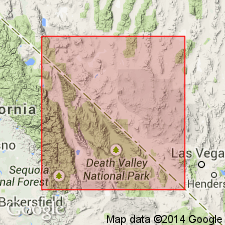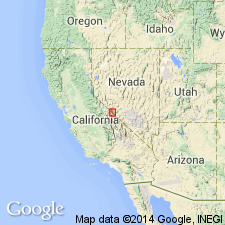
- Usage in publication:
-
- Boundary Peak granite
- Modifications:
-
- Original reference
- Dominant lithology:
-
- Granite
- AAPG geologic province:
-
- Great Basin province
Summary:
Pg. 66. The batholith which forms core of northern Inyo Range is composed chiefly of 2 granites which are designated Pellisier and Boundary Peak granites. The Pellisier is of variable composition and texture, but may be described as hornblende granite with monzonitic tendencies. The Boundary Peak granite, of more uniform appearance and composition, contains no hornblende and has a lower percentage of other ferromagnesian minerals. [Age and derivation of names not stated.]
Source: US geologic names lexicon (USGS Bull. 896, Pellisier entry p. 1630).

- Usage in publication:
-
- Boundary Peak granite
- Modifications:
-
- Overview
- AAPG geologic province:
-
- Great Basin province
Summary:
Pg. 8-11. The granites [Pellisier and Boundary Peak] are probably equivalent in age to the Sierra Batholith -middle or [late] Mesozoic. Derivation of name given.
Composes Montgomery Peak and Boundary Peak, at extreme end of Inyo Range, east-central CA.
Source: US geologic names lexicon (USGS Bull. 1200, p. 441).
For more information, please contact Nancy Stamm, Geologic Names Committee Secretary.
Asterisk (*) indicates published by U.S. Geological Survey authors.
"No current usage" (†) implies that a name has been abandoned or has fallen into disuse. Former usage and, if known, replacement name given in parentheses ( ).
Slash (/) indicates name conflicts with nomenclatural guidelines (CSN, 1933; ACSN, 1961, 1970; NACSN, 1983, 2005, 2021). May be explained within brackets ([ ]).

